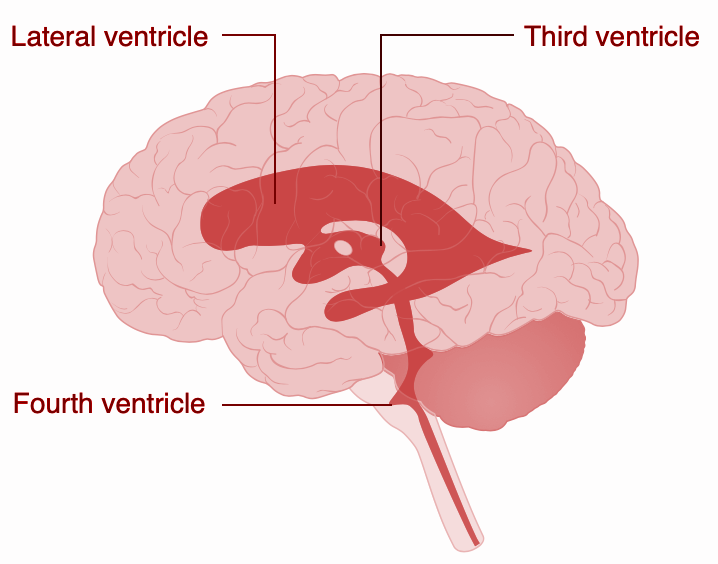
The third ventricle of the brain is situated in the
(a) Base of the telencephalon
(b) Roof of the metencephalon
(c) Roof of the diencephalon
(d) Base of the prosencephalon
Answer
494.4k+ views
Hint: The brain's third ventricle is located in one of the brain's main vesicles developed during embryogenesis. To this particular vesicle is attached the optic nerve. It is the area of the neural tube of the embryonic vertebrate that gives rise to structures of the anterior forebrain, including the thalamus, hypothalamus, the pituitary gland’s posterior portion, and the pineal gland.
Complete Step by Step Answer:
The third ventricle is a median cleft between the two thalami in the diencephalon and is filled with cerebrospinal fluid.
Diencephalon is a part of the forebrain that is an embryonic prosencephalon and is located between the telencephalon and the midbrain which is the embryonic mesencephalon.
It is composed of structures on either side of the third ventricle, including the thalamus, the hypothalamus, the epithalamus, and the subthalamus.
The telencephalon contains lateral ventricles.
The fourth ventricle is in the hindbrain and includes the metencephalon and the myelencephalon. The metencephalon includes both pons and cerebellum.
Mesencephalon sits on the midbrain.

The ventricular system is a collection of cavities which communicate within the brain. These systems are responsible for processing, storing, and extracting cerebrospinal fluid that is bathed in the central nervous system. The lateral left and right ventricles are positioned within their respective cerebral hemispheres. They've got 'horns' extending into frontal, occipital, and temporal lobes. Lateral ventricle volume increases with age.
So, the correct answer is, ‘Roof of diencephalon’.
Note: The third ventricle anteriorly interacts with the lateral ventricles by interventricular foramina (foramen of Monro) . It also interacts posteriorly by the cerebral aqueduct (of Sylvius) with the fourth ventricle. The diencephalon serves as the primary center for transmitting and processing sensory information and autonomic function. The plethora of communication pathways between these structures and other body parts make the diencephalon a functionally related area.
Complete Step by Step Answer:
The third ventricle is a median cleft between the two thalami in the diencephalon and is filled with cerebrospinal fluid.
Diencephalon is a part of the forebrain that is an embryonic prosencephalon and is located between the telencephalon and the midbrain which is the embryonic mesencephalon.
It is composed of structures on either side of the third ventricle, including the thalamus, the hypothalamus, the epithalamus, and the subthalamus.
The telencephalon contains lateral ventricles.
The fourth ventricle is in the hindbrain and includes the metencephalon and the myelencephalon. The metencephalon includes both pons and cerebellum.
Mesencephalon sits on the midbrain.

The ventricular system is a collection of cavities which communicate within the brain. These systems are responsible for processing, storing, and extracting cerebrospinal fluid that is bathed in the central nervous system. The lateral left and right ventricles are positioned within their respective cerebral hemispheres. They've got 'horns' extending into frontal, occipital, and temporal lobes. Lateral ventricle volume increases with age.
So, the correct answer is, ‘Roof of diencephalon’.
Note: The third ventricle anteriorly interacts with the lateral ventricles by interventricular foramina (foramen of Monro) . It also interacts posteriorly by the cerebral aqueduct (of Sylvius) with the fourth ventricle. The diencephalon serves as the primary center for transmitting and processing sensory information and autonomic function. The plethora of communication pathways between these structures and other body parts make the diencephalon a functionally related area.
Latest Vedantu courses for you
Grade 11 Science PCM | CBSE | SCHOOL | English
CBSE (2025-26)
School Full course for CBSE students
₹41,848 per year
Recently Updated Pages
Master Class 11 Economics: Engaging Questions & Answers for Success

Master Class 11 Business Studies: Engaging Questions & Answers for Success

Master Class 11 Accountancy: Engaging Questions & Answers for Success

Master Class 11 English: Engaging Questions & Answers for Success

Master Class 11 Computer Science: Engaging Questions & Answers for Success

Master Class 11 Maths: Engaging Questions & Answers for Success

Trending doubts
State and prove Bernoullis theorem class 11 physics CBSE

1 ton equals to A 100 kg B 1000 kg C 10 kg D 10000 class 11 physics CBSE

State the laws of reflection of light

One Metric ton is equal to kg A 10000 B 1000 C 100 class 11 physics CBSE

1 Quintal is equal to a 110 kg b 10 kg c 100kg d 1000 class 11 physics CBSE

Difference Between Prokaryotic Cells and Eukaryotic Cells




